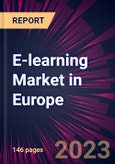Speak directly to the analyst to clarify any post sales queries you may have.
The report offers an up-to-date analysis regarding the current market scenario, the latest trends and drivers, and the overall market environment. The market is driven by availability of subject proficiency assessments and certifications, growing emphasis on personalized learning, and rising adoption of digital platform-enabled education.
The e-learning market in europe is segmented as below:
By Product
- Packaged content
- Solutions
By Application
- Higher education
- Corporate
- K-12
By Geographical Landscape
- Europe
The report on the e-learning market in europe covers the following areas:
- E-learning market in europe sizing
- E-learning market in europe forecast
- E-learning market in europe industry analysis
The study was conducted using an objective combination of primary and secondary information including inputs from key participants in the industry. The report contains a comprehensive market and vendor landscape in addition to an analysis of the key vendors.
The report presents a detailed picture of the market by the way of study, synthesis, and summation of data from multiple sources by an analysis of key parameters such as profit, pricing, competition, and promotions. It presents various market facets by identifying the key industry influencers. The data presented is comprehensive, reliable, and a result of extensive primary and secondary research. The market research reports provide a complete competitive landscape and an in-depth vendor selection methodology and analysis using qualitative and quantitative research to forecast accurate market growth.
Table of Contents
Executive Summary
The following companies are recognized as the key players in the e-learning market in Europe: Adobe Inc., Articulate Global Inc., Cegos Group, Cengage Learning Inc., Cisco Systems Inc., City and Guilds Group, D2L Inc., Docebo Inc., Hive Learning Ltd., Hubken Group Ltd., Instructure Holdings Inc., John Wiley and Sons Inc., Learning Technologies Group PLC, Mind Gym PLC, MPS Ltd., NIIT Ltd., Pearson PLC, Sanako, Simplilearn, and Skillsoft Corp..Commenting on the report, an analyst from the research team said: "The latest trend gaining momentum in the market is rising adoption of content gamification in digital education."
According to the report, one of the major drivers for this market is the availability of subject proficiency assessments and certifications.
The study was conducted using an objective combination of primary and secondary information including inputs from key participants in the industry. The report contains a comprehensive market and vendor landscape in addition to a SWOT analysis of the key vendors.
Companies Mentioned (Partial List)
A selection of companies mentioned in this report includes, but is not limited to:
- Adobe Inc.
- Articulate Global Inc.
- Cegos Group
- Cengage Learning Inc.
- Cisco Systems Inc.
- City and Guilds Group
- D2L Inc.
- Docebo Inc.
- Hive Learning Ltd.
- Hubken Group Ltd.
- Instructure Holdings Inc.
- John Wiley and Sons Inc.
- Learning Technologies Group Plc
- Mind Gym Plc
- MPS Ltd.
- NIIT Ltd.
- Pearson Plc
- Sanako
- Simplilearn
- Skillsoft Corp.








